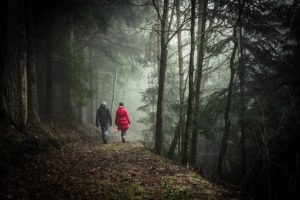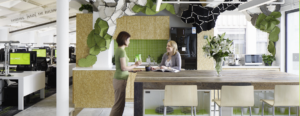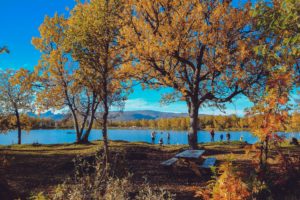

Features
Biophilic Design Precedents: Three Perspectives on Evidence & Ideation
Catie Ryan
Share
Learn more about our biophilic design work and services by emailing us at [email protected] and reading our reports, 14 Patterns of Biophilic Design and The Economics of Biophilia. Follow the conversation on twitter: @TerrapinBG | #14Patterns.
As practitioners of biophilic design, we are ever thirsty for design precedents. We are perpetually in search of tried and true evidence – the kind that corroborates myriad anecdotes and supports the relationships between nature, design, and our health and wellbeing – all to get buy-in from clients and collaborators. The challenge of this endeavor is that the evolution of design thinking moves faster than the process of scientific reporting.
In fact, it takes an average of 17 years for research evidence to become practice (Morris et al, 2011; Green et al, 2009). While this summation oversimplifies the complexities of translational medical research, policy, and adoption, it highlights the challenge design practitioners face in identifying precedents that represent a response to today’s trending awareness of the correlations between public health issues in the built environment and connectedness to nature (e.g., Mayer & Franz, 2004). Health data privacy, perceptions of competitive advantage, risk of exposing intellectual property, slow uptake of post-occupancy evaluation practices, and incomplete feedback loops collectively contribute to the dearth of documented biophilic design precedents. Consequently, we are limited to the judgement and drive of a self-selected few to make a compelling story, one that often lacks the financial or health data to capture the attention of owners and investors and ignite broad adoption.
To effectively respond to public health and wellness issues using biophilic design concepts and interventions, processes for developing and sharing topical evidence and ideas are desperately needed. We are otherwise confronted with the potentially ironic greenwashing of our ‘intuitive’ nature connection through overuse of potted plants and pretty pictures – already a recurring concern among industry thought leaders and practitioners alike.
As part of the ongoing discussion to effectuate progress and broad adoption of informed biophilic design practices, I’d like to share three perspectives that define or guide our way of thinking about, qualifying, and building healthy spaces
1. Bridging the Gap Between Science and Practice

There is a growing interest in replicating the benefits of forest bathing in urban parks. Harvard University School of Public Health’s CHGE published the Natural Environments Initiative, a paper that envisions exposure to nature as part of a larger public health strategy. Image: Sebastian Pichler/Unsplash CC0
Diffusion theorist, epidemiologist, and biostatistician Dr. Lawrence W. Green and colleagues stress that to bridge the gap between science and practice, we need to be able to approach the challenge from two complementary directions, both evidence-based practices and practice-based evidence, to contribute to what they describe as “better-informed, more relevant and actionable practices and policies” (Green et al, 2009).
Evidence-based practices (EBP) are valued for their ability to provide an explicit rationale to support design decisions, including a line of accountability and parameters for scaling-up clinically relevant research. With EBP, onus is on researchers to translate this evidence for practitioner implementation. But biophilic design in practice is inherently multidisciplinary, reaching well beyond clinical applications. Performance verification for biophilic design interventions is also far from standard protocol, making it challenging to rely on evidence-based practices alone as a strategy for broad adoption.
Despite the 17-year evidence-to-practice timeline, inadequate resources, and paucity of valid empirical evidence, EBPs have become a foundational strategy for establishing justified precedents for biophilic design, particularly in the healthcare sector and, increasingly so, in commercial workplace real estate. How this translates to other sectors is thus far riddled with assumptions – knowledge gaps that evidence-based research is unable to appease fast enough.
There are between 75 and 100 outdoor “park prescription” programs nationwide (Seltenrich, 2015) administered by a range of organizations, including Massachusetts General Hospital, Appalachian Mountain Club, San Francisco’s Golden Gate National Parks Conservancy, and the US National Parks Service, each of which is aimed at improving the health of children. The mere existence of these programs is testament to what research evidence has done thus far to educate us on the value of nature in supporting a healthy society. Government supported projects such as the Shinrin-yoku (forest bathing) program in Japan aimed at stress management, and the Green Road Project in Maryland (administered by the Institute for Integrative Health and the US Department of Defense) for military veterans coping with PTSD, also acknowledge the benefits of nature-immersion while simultaneously facilitating more research. Contextually, however, these are all outdoor programs that do not easily translate to solutions for the built environment..
2. Proving the Intuitively Obvious
Securing program funds – to validate assumptions and document the positive health impacts of nature on building occupants – is a continuous challenge. Sustainability and biophilia thought leader Bill Browning refers to this endeavor as “proving the intuitively obvious”. Herein lies a most valid point – why spend money on proving what we already know to be true? The simple answer is that as an industry we are not following our intuition.
In response to this conundrum, we’re seeing an increased leveraging of diversified, small-scale research tactics and affordable technologies to help build a body of practice-based evidence (PBE) for biophilic design in the built environment. Methods for corroborating data from indoor and outdoor experiences are rich in opportunity:
- Wrist bands, headsets, and chest straps for monitoring human health responses
- Smartphone apps, sleep monitors, gaze attention devices, urban intelligence platforms, and observation for monitoring user behavior trends
- Air quality monitors and light meters for tracking and measuring ambient environmental attributes
- Virtual reality, stress mapping, and geo-mapping to conceptualize correlations between physical space, human behavior, and health responses
Highly replicable strategies for developing practice-based evidence present an opportunity to compliment EBPs, both by filling knowledge gaps and in assisting with contextualization of evidence. Post Occupancy Evaluation (POE) is one of the more practical, adaptable, and accessible tools we have at our disposal. Since POEs are typically focused on application (Zimring & Reizenstein, 1980), they are a form of practice-based evidence, one that has the potential to be standardized but is severely underutilized in the design world. Other examples of PBE includes correlating physical measurements with complaint logs and health data, in-field experimentation, biophilic design reviews, and the exploration of metrics or parameters that support biophilic design, such as the WELL Building Standard® and the Living Building Challenge.

Glumac’s Shanghai office deliberately integrated biophilic design into their sustainable design strategy, then conducted a post-occupancy survey to understand which design aspects employees most valued. Their case study also documents some important lessons learned during the design and engineering processes. Image courtesy of Glumac
With the rise in wearable tech and non-invasive health monitoring devices, basic metrics for heart rate, brain waves, and salivary cortisol can be administered and tracked by the citizen scientist. While notably less scientifically rigorous than traditional research methods, the primary benefits to PBE are the expediency of data collection, reporting, and action; potential for widespread replicability with consistent metrics; ownership by citizens of their own lifestyle and design choices; and the industry-relevant nature of the research effort that helps enable immediate action.
These tools, in combination, are being used to help understand design performance challenges and opportunities while focusing on targeted health issues like stress management, restoration, and perceptions of privacy and comfort, that can be improved with greater connectedness to nature.
3. Communication and the Emotional Connection
Diffusion theory – how, why, and at what rate new ideas and technologies spread among different groups – suggests that the adoption of biophilic design may differ depending on how we communicate, the channels we use, and to which audiences. Presumably, creating a demand for biophilic built environments and acting on a willingness to share lessons learned are also determinants of how long it might take to establish a critical mass of advocates and practitioners.

Escorting clients and collaborators through a biophilic experience can help communicate with authenticity the type of emotional connection to nature that you may be aiming to introduce to your project. Image: Linh Phan/Unsplash CC0
Thus far, as an industry we have largely relied on science and images to communicate the benefits of the biophilic experience. The ability to capture one’s emotional connection to a place through language or imagery tends to be a skill unique to the seasoned poet or photographer. Communicating the multisensory experience, however, is necessary to gain a holistic appreciation of why a place is valued – experientially, psycho-physiologically, and socioeconomically. Escorting someone through a biophilic space can be an effective way of communicating what images and words cannot – that subtle, or sometimes blatant, qualities of nature have distinct influence over how we perceive, process, and respond to our experience of space and place. These physical or temporal experiences that allow us to better comprehend relationships with nature, help distinguish justified belief from opinion, even without scientific evidence to back it up. Thus, the intrinsic value of the emotional connection is emerging within the biophilic design movement as a viable communication tool, both to inspire the curious and convert the wary.
Final Thoughts
Since not all people have access to amazing biophilic environments, I wonder how we effectively communicate those experiences remotely and broadly. Finding an acceptable balance between these differing types of evidence may be the key to gaining greater momentum in the quest for broad adoption of biophilic design.
In Terrapin’s years of experience, we have found that the ‘how’ and ‘what’ of biophilic design research and implementation may differ from project to project, but the overarching ‘why’ is unwavering – to improve human health and wellbeing. Regardless of whether the ‘why’ is based on scientific evidence, personal experience, observation, economics, or a combination of these things, the ability to communicate the ‘why’ may be the strongest tool in your arsenal.
We’ve also found that sharing success stories and lessons learned is paramount to advancing industry adoption of biophilic design. Here are some of ours. I hope you feel inspired to share yours.
- Industry and Observational Surveys have helped confirm assumptions around user trends, pricing, and perceived value [e.g., Hospitality survey].
- Design Guidelines and Design Reviews have been a popular and replicable tool for aligning health and design owner project requirements [e.g., Clif Bar profile].
- Post-Occupancy Evaluations have been particularly effective at telling a story while providing valuable insight for prioritizing workplace design for improved stress management [e.g., CookFox case study].
- Publications have been fundamental to creating industry-wide dialogue [see Terrapin’s Publications].
*Both the header and feature images are creative commons zero (CC0).
External Resources
-
Maryland Dept of Nat Res Wounded Warrior and Veteran Outreach Program. Recreational opportunities for Maryland’s wounded warriors, veterans, and their families to aid in the veteran’s mental and physical well-being and establish a new base of potential employees.
-
Institute for Integrative Health Green Road Project. A 2-acre healing forest for injured war veterans. The first of five metrics (from the Epidaurus Project; Esther Sternberg, MD, and Julian Thayer, PhD) combines heart rate variability, salivary cortisol, and neuroimmune biomarkers into a single expression to give a broader measure of allostatic load. (Advanced mathematics, using successive mean difference and multilevel regression models, are required).
-
Association Nature & Forest Therapy Guides & Programs. With a mission to “mobilize health care networks to connect people with nature” the association provides training programs, resources, and networking for certified guides.
References
-
Green LW, Ottoson JM, García C, Hiatt RA. Diffusion theory and knowledge dissemination, utilization, and integration in public health. Annu Rev Public Health 2009;30:151–74
-
Mayer FS, Franz CM. The connectedness to nature scale: A measure of individuals’ feeling in community with nature. Journal of Environmental Psychology 24 (2004) 503–515
-
Morris ZS, Wooding S, Grant J. The answer is 17 years, what is the question: understanding time lags in translational research. J R Soc Med December 2011;104:12510-520. doi: 10.1258/jrsm.2011.110180
-
Seltenrich, Nate. Using Parks to Improve Children’s Health. Environmental Health Perspectives 2015, 123(10):A255
-
Zimring, Craig M. & Reizenstein, Janet E. Post-Occupancy Evaluation An Overview. Environment and Behavior December 1980 vol. 12 no. 4 429-450. doi: 10.1177/0013916580124002
Filed under:
Catie Ryan
Catie is the Director of Projects at Terrapin and a leader in biophilic design movement. With a background in urban green infrastructure, Catie's interest lies in systems thinking to address human health and sustainability challenges at each scale of the built environment.
Topics
- Occupant Comfort
- Materials Science
- Speaking
- LEED
- Terrapin Team
- Phoebe
- Community Development
- Greenbuild
- Technology
- Biophilic Design Interactive
- Catie Ryan
- Spanish
- Hebrew
- French
- Portuguese
- Publications
- Carbon Neutrality
- Environmental Values
- Conference
- Psychoacoustics
- Education
- Workshop
- Mass Timber
- Transit
- Carbon Strategy
- connection with natural materials
- interior design
- inspirational hero
- biophilia
- economics of biophilia
- Sustainability
- Systems Integration
- Biophilic Design
- Commercial
- Net Zero
- Resorts & Hospitality
- Energy Utilization
- Water Management
- Corporations and Institutions
- Institutional
- Ecosystem Science
- Green Guidelines
- Profitability
- Climate Resiliency
- Health & Wellbeing
- Indoor Environmental Quality
- Building Performance
- Bioinspired Innovation
- Biodiversity
- Residential
- Master Planning
- Architects and Designers
- Developers and Building Owners
- Governments and NGOs
- Urban Design
- Product Development
- Original Research
- Manufacturing
- Industrial Ecology
- Resource Management
- Sustainability Plans
- Health Care


